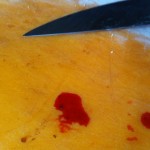
Pom-icide
A reminder that photographs were once seen as incontrovertible evidence. And that contemporary images can still play with this trope – transforming the ordinary kitchen spill into a gruesome document.
Not to compare my own cameraphone captures to Atget’s photographs of empty Paris streets, but Walter Benjamin’s observations on Atget’s images have always seemed like a worthwhile goal to live up to:
“It has justly been said of him that he photographed them like scenes of crimes. A crime scene, too, is deserted; it is photographed for the purpose of establishing evidence. With Atget, photographic records begin to be evidence in the historical process. This constitutes their hidden political significance. They demand a specific kind of reception. Free-floating contemplation is no longer appropriate to them. They unsettle the viewer; he feels challenged to find a particular way to approach them”
Looking at Atget’s work now, I may be too divorced from the politics of the time, as the revolutionary significance that Benjamin ascribes to them is lost on me. However, this notion of photography that unsettles and challenges – photography with an embedded call to action has always stuck with me. It’s easy to consider photojournalistic applications of this (pepper spraying cop, Thích Quảng Đức, Tank Man), but what could the fictional applications be?
Do they look like Dark Score Stories? Jeff Wall‘s “cinematographic” images? Antonioni’s “Blow-Up“? Something else?


